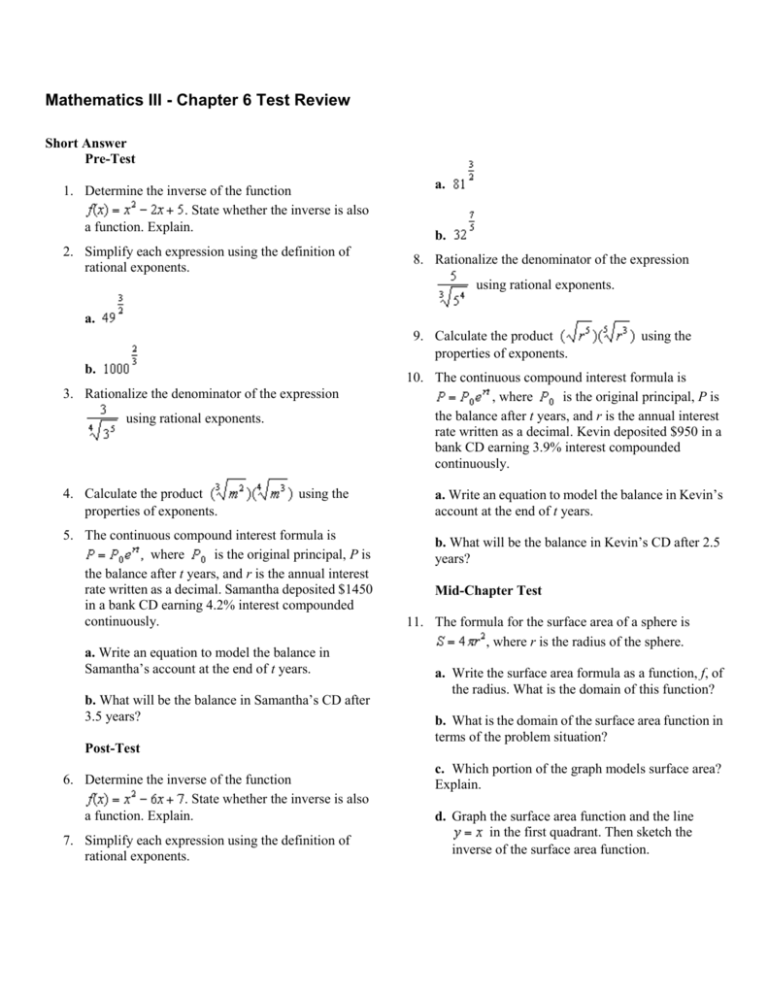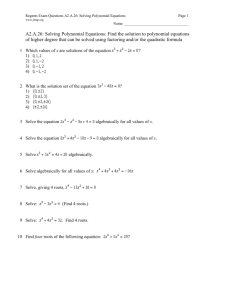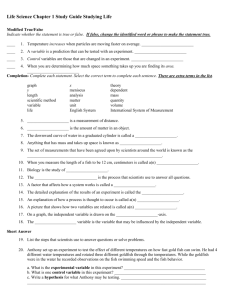Mathematics III - Chapter 6 Test Review Answer Section
advertisement

Mathematics III - Chapter 6 Test Review Short Answer Pre-Test 1. Determine the inverse of the function . State whether the inverse is also a function. Explain. 2. Simplify each expression using the definition of rational exponents. a. b. 8. Rationalize the denominator of the expression using rational exponents. a. 9. Calculate the product properties of exponents. b. 3. Rationalize the denominator of the expression using rational exponents. 4. Calculate the product properties of exponents. using the 5. The continuous compound interest formula is where is the original principal, P is the balance after t years, and r is the annual interest rate written as a decimal. Samantha deposited $1450 in a bank CD earning 4.2% interest compounded continuously. a. Write an equation to model the balance in Samantha’s account at the end of t years. b. What will be the balance in Samantha’s CD after 3.5 years? Post-Test 6. Determine the inverse of the function . State whether the inverse is also a function. Explain. 7. Simplify each expression using the definition of rational exponents. using the 10. The continuous compound interest formula is , where is the original principal, P is the balance after t years, and r is the annual interest rate written as a decimal. Kevin deposited $950 in a bank CD earning 3.9% interest compounded continuously. a. Write an equation to model the balance in Kevin’s account at the end of t years. b. What will be the balance in Kevin’s CD after 2.5 years? Mid-Chapter Test 11. The formula for the surface area of a sphere is , where r is the radius of the sphere. a. Write the surface area formula as a function, f, of the radius. What is the domain of this function? b. What is the domain of the surface area function in terms of the problem situation? c. Which portion of the graph models surface area? Explain. d. Graph the surface area function and the line in the first quadrant. Then sketch the inverse of the surface area function. a. b. 16. Simplify each radical. a. b. e. Determine the inverse of the surface area algebraically. Is the inverse a function? Is the inverse in terms of the problem situation a function? Explain. 12. Determine the inverse of each function. State whether the inverse is also a function. Explain. a. 17. Perform each multiplication or division by converting to rational exponents. a. b. b. 13. Simplify each expression using the definition of rational exponents. 18. Rationalize each denominator using rational exponents. a. a. b. b. c. 14. Write each expression in radical form. 19. Calculate each product and quotient using the properties of exponents. a. a. b. b. End of Chapter Test 15. Write each expression in exponential form and simplify if possible. 20. Consider the cubic function . a. Determine the inverse of b. Is the inverse of algebraically. also a function? Explain. 21. Simplify each expression using the definition of rational exponents. 25. The continuous compound interest formula is , where is the original principal, P is the balance after t years, and r is the annual interest rate written as a decimal. Nicole deposited $1200 in a bank CD earning 3.6% interest compounded continuously. a. Write an equation to model the balance in Nicole’s account at the end of t years. a. b. What will be the value of Nicole’s CD after 4.5 years? b. 22. Simplify each radical. a. c. If Nicole’s money stays deposited at the same interest rate with no additional deposits and no withdrawal, to the nearest tenth of a year, how long will it take for the value of the account to double? Explain your work. b. 23. Perform each multiplication or division by converting to rational exponents. 26. The formula for radioactive decay is , where N is the amount of radioactive material after time t, is the original amount, and is the half-life. Barium-140 has a half-life of 12.74 days. a. a. Write an equation for the decay of 200 grams of Barium-140. b. 24. The formula to determine the balance of a compound-interest bank account after t years is , where P is the current balance, is the original principal, r is the annual interest rate written as a decimal, and n is the number of times per year that the interest is compounded. Zach deposited $800 in a bank CD earning 4.0% interest compounded quarterly (four times a year). a. Write an equation to model the balance in Zach’s account at the end of t years. b. What will be the value of Zach’s CD after 18 months? c. How long will it take for the value of the account to reach $1000 to the nearest tenth of a year? Explain your work. b. How much radioactive material will be left after 20 days to the nearest tenth of a kilogram? c. When will there be 10 kilograms of the radioactive material left to the nearest day? Explain your work. Mathematics III - Chapter 6 Test Review Answer Section SHORT ANSWER 1. ANS: The inverse is not a function because the original quadratic function is not one-to-one. PTS: 1 2. ANS: REF: Ch6.L1 STA: MM2A5 TOP: Pre Test PTS: 1 TOP: Pre Test 3. ANS: REF: Ch6.L2 STA: MM3A2a | MM3A2b PTS: 1 TOP: Pre Test 4. ANS: REF: Ch6.L3 STA: MM3A2a | MM3A2b PTS: 1 TOP: Pre Test 5. ANS: a. REF: Ch6.L3 STA: MM3A2a | MM3A2b a. b. b. The balance in Samantha’s account after 3.5 years will be $1679.61. PTS: 1 6. ANS: REF: Ch6.L6 STA: MM3A2g TOP: Pre Test The inverse is not a function because the original quadratic function is not one-to-one. PTS: 1 7. ANS: REF: Ch6.L1 STA: MM2A5 TOP: Post Test PTS: 1 TOP: Post Test 8. ANS: REF: Ch6.L2 STA: MM3A2a | MM3A2b PTS: 1 TOP: Post Test 9. ANS: REF: Ch6.L3 STA: MM3A2a | MM3A2b PTS: 1 TOP: Post Test 10. ANS: a. REF: Ch6.L3 STA: MM3A2a | MM3A2b a. b. b. The balance in Kevin’s account after 2.5 years will be $1047.29. PTS: 1 REF: Ch6.L6 STA: MM3A2g 11. ANS: a. The domain of the function is all real numbers. TOP: Post Test b. The domain in terms of the problem situation is all real numbers greater than or equal to zero. c. Only the first quadrant models surface area because surface area cannot be negative. d. e. The equation of the inverse relation for the original function is . This relation is not a function because the original quadratic function is not one-to-one. The function in terms of the problem situation is one-to-one. So, the inverse in terms of the problem situation is a function and is represented by PTS: 1 12. ANS: REF: Ch6.L1 STA: MM2A5 TOP: Mid Ch Test . a. The inverse is a function because all linear functions are one-to-one. b. The inverse is not a function because the original quadratic function is not one-to-one. PTS: 1 13. ANS: REF: Ch6.L1 STA: MM2A5 TOP: Mid Ch Test a. b. c. PTS: 1 REF: Ch6.L2 TOP: Mid Ch Test 14. ANS: STA: MM3A2a | MM3A2b a. b. PTS: 1 REF: Ch6.L2 STA: MM3A2a | MM3A2b TOP: Mid Ch Test 15. ANS: a. b. PTS: 1 REF: Ch6.L2 TOP: Mid Ch Test 16. ANS: STA: MM3A2a | MM3A2b a. b. PTS: 1 REF: Ch6.L3 TOP: Mid Ch Test 17. ANS: STA: MM3A2a | MM3A2b a. b. PTS: 1 REF: Ch6.L3 TOP: Mid Ch Test 18. ANS: STA: MM3A2a | MM3A2b a. b. PTS: 1 REF: Ch6.L3 TOP: Mid Ch Test 19. ANS: STA: MM3A2a | MM3A2b a. b. PTS: 1 REF: Ch6.L3 TOP: Mid Ch Test 20. ANS: a. STA: MM3A2a | MM3A2b b. The inverse is a function because the original cubic function is one-to-one. PTS: 1 21. ANS: a. b. REF: Ch6.L1 STA: MM2A5 TOP: End Ch Test PTS: 1 TOP: End Ch Test 22. ANS: REF: Ch6.L2 STA: MM3A2a | MM3A2b REF: Ch6.L3 STA: MM3A2a | MM3A2b REF: Ch6.L3 STA: MM3A2a | MM3A2b a. b. PTS: 1 TOP: End Ch Test 23. ANS: a. b. PTS: 1 TOP: End Ch Test 24. ANS: a. b. The value of Zach’s account after 18 months will be $849.22. c. I would graph the exponential function and the linear function on the same screen in my graphing calculator. I would use my calculator to determine where the two graphs intersect. The point of intersection is approximately (5.606, 1000). So, to the nearest tenth of a year, it would take about 5.6 years for the value of the account to reach $1000. PTS: 1 25. ANS: a. REF: Ch6.L6 STA: MM3A2g TOP: End Ch Test b. The value of Nicole’s account after 4.5 years will be $1411.03. c. I would graph the exponential function and the linear function on the same screen in my graphing calculator. I would use my calculator to determine where the two graphs intersect. The point of intersection is approximately (19.254, 2400). So, it would take about 19.3 years for the value of the account to double. PTS: 1 26. ANS: REF: Ch6.L6 STA: MM3A2g TOP: End Ch Test a. b. There will be approximately 67.4 kg of Barium-140 left after 20 days. c. I would graph the exponential function and the linear function on the same screen in my graphing calculator. I would use my calculator to determine where the two graphs intersect. The point of intersection is approximately (55.06, 10). So, there will be 10 kg of Barium-140 left after 55 days. PTS: 1 REF: Ch6.L6 STA: MM3A2g TOP: End Ch Test









